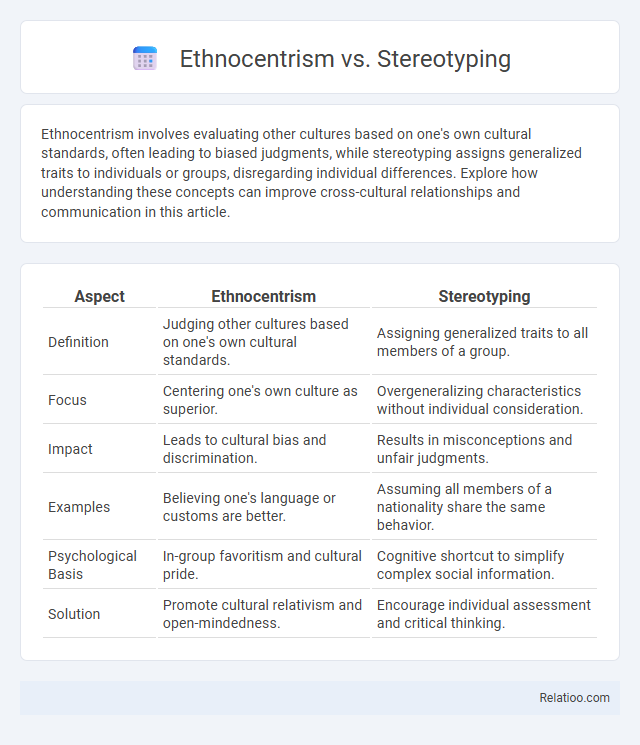Ethnocentrism involves evaluating other cultures based on one's own cultural standards, often leading to biased judgments, while stereotyping assigns generalized traits to individuals or groups, disregarding individual differences. Explore how understanding these concepts can improve cross-cultural relationships and communication in this article.
Table of Comparison
| Aspect | Ethnocentrism | Stereotyping |
|---|---|---|
| Definition | Judging other cultures based on one's own cultural standards. | Assigning generalized traits to all members of a group. |
| Focus | Centering one's own culture as superior. | Overgeneralizing characteristics without individual consideration. |
| Impact | Leads to cultural bias and discrimination. | Results in misconceptions and unfair judgments. |
| Examples | Believing one's language or customs are better. | Assuming all members of a nationality share the same behavior. |
| Psychological Basis | In-group favoritism and cultural pride. | Cognitive shortcut to simplify complex social information. |
| Solution | Promote cultural relativism and open-mindedness. | Encourage individual assessment and critical thinking. |
Understanding Ethnocentrism: Definition and Origins
Ethnocentrism is the belief in the inherent superiority of one's own ethnic group or culture, often leading to judgment and misunderstanding of other cultures. This concept originates from the natural human tendency to evaluate and interpret the world through the lens of one's own cultural norms and values. Understanding ethnocentrism helps you recognize biases in perception and fosters greater cultural sensitivity in diverse social interactions.
Defining Stereotyping: Concepts and Impacts
Stereotyping involves assigning generalized and often oversimplified beliefs about a group, which can lead to unfair judgments and reinforce prejudice. Your perceptions may be shaped by these fixed ideas, reducing individuals to limited traits without recognizing their unique attributes. Understanding the difference between ethnocentrism, stereotyping, and prejudice is crucial to overcoming biased attitudes and promoting cultural sensitivity.
Key Differences Between Ethnocentrism and Stereotyping
Ethnocentrism involves judging another culture solely by the values and standards of one's own culture, often leading to viewing one's culture as superior. Stereotyping simplifies and generalizes characteristics, behaviors, or traits attributed to a group, regardless of cultural context. Key differences include ethnocentrism's focus on cultural judgment and hierarchy, while stereotyping centers on fixed, oversimplified beliefs about groups without necessarily implying cultural superiority.
Psychological Roots of Ethnocentrism
Ethnocentrism stems from psychological roots such as in-group favoritism, social identity theory, and cognitive biases like the tendency to categorize people into "us" versus "them." This psychological mechanism enhances group cohesion but often leads to prejudice and discrimination by viewing other cultures as inferior or threatening. In contrast, stereotyping involves oversimplified generalizations that may not be rooted in strong group identity but still reinforce biased perceptions.
How Stereotypes Develop and Spread
Stereotypes develop through generalized beliefs formed by repeated social interactions and cultural narratives that simplify complex social groups. Media representations, institutional practices, and peer influences contribute to the reinforcement and widespread dissemination of these oversimplified images. Once established, stereotypes persist by shaping perceptions and behaviors, often leading to biased attitudes and discrimination in diverse societies.
Real-World Examples of Ethnocentrism
Ethnocentrism manifests when individuals judge other cultures solely by the values and standards of their own, often leading to misunderstandings and conflict, such as during colonial powers imposing their customs on indigenous populations. Unlike stereotyping, which involves oversimplified generalizations about groups, ethnocentrism reflects a deeper belief in cultural superiority, influencing your interactions and decisions. Real-world examples include Western disdain for non-Western medical practices and the preference for native language in multicultural workplaces, illustrating how ethnocentrism shapes social dynamics and policy.
The Consequences of Stereotyping in Society
Stereotyping leads to generalized assumptions that oversimplify complex individual identities, fostering prejudice and social division. This distortion undermines social cohesion by perpetuating unfair biases and limiting opportunities for marginalized groups, thereby reinforcing systemic inequalities. In contrast, ethnocentrism intensifies these effects by promoting cultural superiority, which exacerbates discrimination and conflict within diverse societies.
Ethnocentrism in Cross-Cultural Communication
Ethnocentrism in cross-cultural communication refers to evaluating other cultures based on the standards and values of your own culture, often leading to misunderstandings and biased judgments. This mindset can create barriers by dismissing cultural differences and fostering misinterpretations during intercultural interactions. Overcoming ethnocentrism requires awareness and openness to cultural diversity, which improves communication effectiveness and mutual respect.
Combating Ethnocentrism and Stereotyping: Strategies for Change
Combating ethnocentrism and stereotyping requires fostering intercultural competence through education that emphasizes empathy, cultural awareness, and critical thinking. Encouraging direct intercultural interactions and dialogue reduces biases by humanizing diverse groups and dismantling false assumptions. Institutional policies promoting diversity and inclusion create environments where different perspectives are valued, ultimately weakening ethnocentric attitudes and stereotypical thinking.
Promoting Cultural Awareness and Inclusivity
Ethnocentrism, stereotyping, and cultural relativism each influence how individuals perceive and interact with diverse cultures, impacting efforts to promote cultural awareness and inclusivity. Ethnocentrism involves viewing one's own culture as superior, which can hinder openness and mutual respect, while stereotyping reduces complex cultural identities to oversimplified, often inaccurate generalizations. Emphasizing cultural relativism fosters inclusivity by encouraging understanding and appreciation of cultural differences without judgment, thereby creating environments that value diversity and reduce prejudice.

Infographic: Ethnocentrism vs Stereotyping
 relatioo.com
relatioo.com